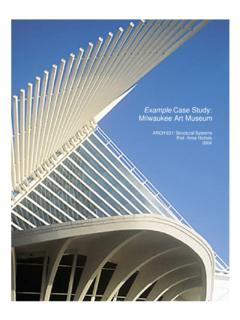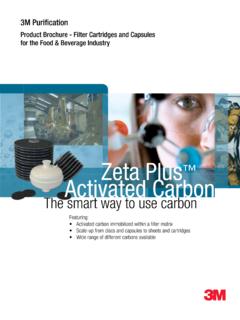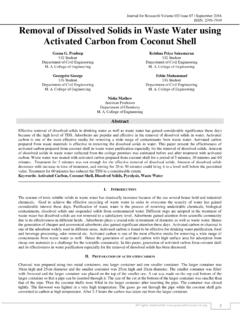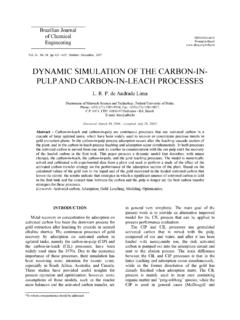Transcription of AN ENERGY EFFICIENT SOLAR ICE-MAKER
1 AN ENERGY EFFICIENT SOLAR ICE-MAKER Department of Mechanical Engineering, University of Hong Kong, Hong Kong. Fax: 852-2858-5415; e-mail: International environment protection initiatives have led to the intensification of research efforts on development of ozone and global warming safe heat pump technology. Adsorption refrigeration has been intensively investigated in Japan, Europe and USA, because of its promising potential for competing with conventional vapor compression refrigeration. During the last decade, a lot of work has been carried out in this field, with a certain amount of success. To reach a truly practical / applicable and cost effective SOLAR refrigeration technology, some key innovation work must be completed. With the progress in the fields of the adsorbent material production and SOLAR ENERGY collecting technology, there is a real possibility to achieve commercialization of such systems.
2 This paper presents the decription and operation of a SOLAR -powered ICE-MAKER with solid adsorption pair of activated carbon and methanol. A domestic type of charcoal is chosen as the adsorbent , and a simple flat-plate collector with an exposed area of m2is employed to produce ice of about 4-5 kg/day. Also, it is intended to introduce a hybrid system consisting of SOLAR water heater and ICE-MAKER , which can satisfy the requirements of both the SOLAR ice-making needs as well as good heat collection and heat release in the adsorber. It is expected that by introducing such method using the newly developed ACF, the total efficiency of the system can be increased by about 30 %. This idea is simple and also expected to be effective, since, the hybrid system of SOLAR powered water heater and refrigerator will be able to satisfy both heating and cooling needs, thereby increasing the total efficiency of the system.
3 Although this device is designed just for SOLAR ENERGY utilization, it can be applied to many ENERGY saving fields such as waste heat recovery in industry, and in the exhaust gas-driven air conditioning. Such a novel concept of ENERGY utilization would also contribute to more EFFICIENT methods for sustainable development. 1. INTRODUCTION In recent years, increasing attention is being given to the use of waste heat and SOLAR ENERGY in energising refrigerating systems. SOLAR powered refrigeration and air conditioning have been very attractive during the last twenty years, since the availability of sunshine and the need for refrigeration both reach maximum levels in the same season. One of the most effective forms of SOLAR refrigeration is in the production of ice, as ice can accumulate much latent heat, thus the size of the ICE-MAKER can be made small.
4 Solid adsorption refrigeration makes use of the unique features of certain adsorbent-refrigerant pairs to complete refrigeration cycles for cooling or heat pump purposes. Zeolite and activated carbon were used as adsorbents in many systems. In the early 1980 s, Tchernev [1] carried out an investigation of adsorption refrigeration with the zeolite+water pair. Also, Pons and Grenier [2] worked on solid adsorption pair of zeolite and water, to produce refrigerating effect achieving a coefficient of performance of only about Later, in 1987, they demonstrated that activated carbon and methanol can serve as a suitable pair for a SOLAR powered, solid-adsorption ICE-MAKER . Critoph [3] had studied the performance limitations of adsorption cycles for SOLAR cooling and concluded that, in general, activated carbon -methanol combination was preferable for SOLAR cooling, which giving the best COP achievable in a single-stage cycle.
5 In order to increase the desorption temperature and have a good cooling effect during the adsorption period at night, Headley et al. [4] constructed a charcoal-methanol adsorption refrigerator powered by CPC concentrating collectors, but the SOLAR COP achieved was very low, of about The recent new development of active carbon series - ACF, shows the possibility for applications in adsorption refrigeration. One good example is the development in Byelorussia where a refrigerator prototype using ACF-ethanol and ACF-acetone pairs has been reported [5]. New experiments have been also shown to use a heat pipe for heating/cooling ACF adsorbers for the ACF-NH3pair. In China, work has been carried out on SOLAR powered refrigerators using different adsorption pairs such as calcium chloride+ammonia, Zeolite+water and activated carbon +methanol. In search of new adsorbent materials [6], Wang et al.
6 Have reported that, for a specially treated ACF, the measured adsorption capacity of methanol is 2 to 3 times greater than that of normal activated carbon , and the estimated adsorption time is only about 1/5 1/10 of that of normal activated carbon . Hence, the recent development of novel adsorbent products and their manufacturing technologies seems to make it possible to achieve new improvements to the performance of SOLAR adsorption units. This paper focus on a SOLAR -powered ICE-MAKER with solid adsorption pair of activated carbon + methanol as well as on the major features of the proposed hybrid system. A simple flat-plate collector having an exposed area of m2is employed to produce ice of about 4-5 kg/day. 2. TECHNICAL BACKGROUND Adsorption refrigeration and heat pump cycles rely on the adsorption of a refrigerant gas into an adsorbent at low pressure and subsequent desorption by heating.
7 The adsorbent acts as a chemical compressor driven by heat. Figure 1 shows the schematic of the SOLAR refrigeration system. It consists of a SOLAR collector, a condenser/heat-exchanger and an evaporator that is placed in a refrigerator box. The inside of the collector is lined with an adsorption bed packed with activated carbon absorbed with methanol. The refrigerator box is insulated and stocked with aluminum trays filled with water. The activated carbon can adsorb a large amount of methanol vapor in ambient temperature and desorb it at a higher temperature (around 100 degrees C). During the daytime, the sunshine irradiates the collector, so the collector is heated up and the methanol is desorbed from the activated carbon . In desorption, the liquid methanol adsorbed in the charcoal heats up and vaporizes. The methanol vapor condenses and is stored in the evaporator.
8 Schematic of a prototype adsorption refrigerator At night, the collector temperature decreases to the ambient temperature, and the charcoal adsorbs the methanol from the evaporator. The liquid methanol in the evaporator vaporizes and adsorbs the heat from the water contained in the trays. The methanol evaporates at a temperature of about 10 degrees C, so the water temperature can be as low as 5 degrees C and becomes icy. Since adsorption is a process of releasing heat, the collector must be cooled efficiently at night. As mentioned above, the ice maker operates in an intermittent way to produce the refrigerating effect. The principle of the solid-adsorption ICE-MAKER is explained using a P-T-X diagram as shown in To begin with, the adsorption bed along with the refrigerant gets heated up, and when it reaches the required desorption temperature(Td1), the methanol gets desorbed.
9 In the evening, the flat-plate collector (adsorption bed) looses its heat to the surroundings and hence the temperature of the adsorbent bed is reduced rapidly (Td2 Ta1), and the pressure in the adsorber drops to a value below evaporation pressure (Pe). Evaporation could happen if the connecting valve is open, and ice will be made in the refrigeration box. collectorcondenserevaporatorinsulationAs explained above, the system works in an intermittent way. This system can be made to operate continuously to produce ice, by incorporating two absorbers such that while one works in desorption mode, the other would be set in for absorption. Alaboratory prototype system built is capable of producing 4 to 5 kg of ice a day and could achieve a COP of about The total size of the ICE-MAKER is about 1 cu m, and weighs about 50 kg. The experimental tests were carried out at various working conditions (-10 C<TE<-5 C evaporation; 30 C<TC<45 C-condensation; 100 C < TG< 105 C generation).
10 The refrigerator performance (Specific cooling power, SCP, and the amount of ice made per day ) at the evaporating temperature limits (TE= -10 Cand TE= 15 C)are shown in Table 1. The performance is relatively low mainly because of the high cycle time(only one cycle a day). Table 1. Refrigerator performance at evaporating temperature limits Evaporation temperature TE( C) Adsorption temperature TA( C) Desorption temperature TD( C) Condensation temperature TC( C) Ice made per day (kg) Specific cooling power (kg-ice/kg- carbon per day) - 10 23 100 21 -5 31 105 31 The full description of the prototype refrigerator built and the analysis of experimental results of the performance of the machine at various working conditions are well documented in yet another paper [7]. 3. KEY ISSUES Several of the disadvantages of adsorption refrigeration have become obstacles for the real mass production of the system.








